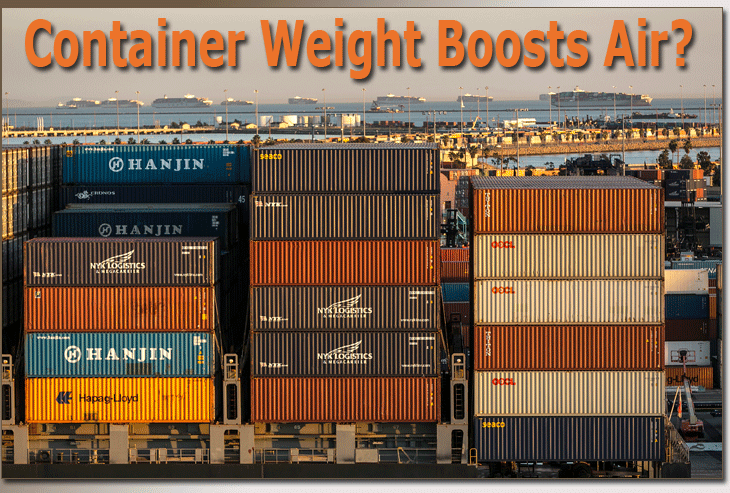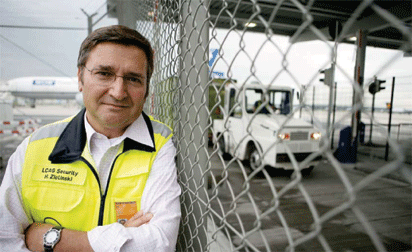| 
Will
container weighing be a boost for air?
 Air
freight demand could be the big beneficiary of new maritime
rules due for introduction this summer. But a whole
range of scenarios are possible, leaving shippers, forwarders,
3PLs, and airlines with plenty of supply chain scenarios
to—quite literally—weigh up, according to
Wolfgang Lehmacher, Head of Supply Chain and Transport
Industries at the World Economic Forum. Air
freight demand could be the big beneficiary of new maritime
rules due for introduction this summer. But a whole
range of scenarios are possible, leaving shippers, forwarders,
3PLs, and airlines with plenty of supply chain scenarios
to—quite literally—weigh up, according to
Wolfgang Lehmacher, Head of Supply Chain and Transport
Industries at the World Economic Forum.
The new rules from the
International Maritime Organization come in the form
of an amendment to the Safety of Life at Sea Convention’s
(Solas) container weighing stipulations. As of July
1, shippers and their proxies will be compelled to verify
the gross weight of packed containers on the bill of
lading before the box can be loaded onboard a vessel.
The move is designed to prevent shipping casualties;
misdeclared box weights have contributed to a number
of incidents in recent years, including the capsizing
of a feeder ship in Spain last year.
However, as previously
reported in FlyingTypers, many analysts have
predicted supply chain disruption and port congestion
this summer as a result of the new rules.
Lehmacher told FlyingTypers
there was still confusion over how the new container
weighing regime would be implemented by each IMO member
state. And, he said, although guidelines had been issued,
they were being interpreted in many different ways.
“All scenarios
are possible, ranging from major delays and disruptions
to very little impact,” he said. “Ideally,
the shippers are going to be prepared and will fulfill
the requirements—that is, the exporter will provide
the complete VGM (verified gross mass container declaration),
including cargo, packing materials, and the container.
The earlier a task is completed throughout the supply
chain the better for costs and service.
“Making weight
checking further down in the process the exception seems
a likely scenario, even though some ports and parties
might have the ability, capacity, and interest to perform
the weighing, welcoming the business opportunity and
revenue.”
But Lehmacher believes
that, in reality, there will be discrepancies around
the world in how the change is managed and this could
lead to some modal shift to air.
“Some of the 171
countries and three associate members of the IMO will
manage the situation well, others will possibly struggle,”
he said. “In case of major disruptions, I hope
stakeholders will take corrective action before the
situation gets out of hand, as happened with the West
Coast port strikes.”
If implementation goes
reasonably well, he said airfreight might benefit initially
through some preemptive measures. “Of course,
if things go wrong, airfreight will benefit in a bigger
way,” he added. “EDI solutions—offered
by companies such as INTTRA, CargoSmart, or Infor/GT
Nexus etc.—might play an important role going
forward."
He also warned that companies
should not just rely on resilience and contingency plans
to manage the change to the new rules.
“With profits and
customer retention at stake on a global scale, retailers
and supply chain managers should seek contact with the
supply chain services providers, mainly transport and
logistics companies, but also governmental agencies
to discuss the approach to the VGM requirement and collaboratively
plan for possible scenarios,” he said.
“The plan should
include the roadmap to compliance, common agreed level
of risk tolerance, and preemptive measures, such as
moving or creating buffer stocks and alternative routings
and potential air lifts.
“This collective
work will also form the basis for timely actions in
case of disruptions.
“Best positioned
are companies with a culture of collaboration, including
well established relations along the supply chain and
with governmental agencies, and a holistic approach
to supply chain management as a collaborative effort.
“The supply chain
champions are prepared and will once again leverage
their competitive advantage to outpace competition and
gain in reputation and market share.”
Sky King |









 Harald believes that a secure air cargo facility relies
on three things: “people; the proactive development,
continual assessment, and assurance of security measures;
and integrated technology.”
Harald believes that a secure air cargo facility relies
on three things: “people; the proactive development,
continual assessment, and assurance of security measures;
and integrated technology.”
 Air
freight demand could be the big beneficiary of new maritime
rules due for introduction this summer. But a whole
range of scenarios are possible, leaving shippers, forwarders,
3PLs, and airlines with plenty of supply chain scenarios
to—quite literally—weigh up, according to
Wolfgang Lehmacher, Head of Supply Chain and Transport
Industries at the World Economic Forum.
Air
freight demand could be the big beneficiary of new maritime
rules due for introduction this summer. But a whole
range of scenarios are possible, leaving shippers, forwarders,
3PLs, and airlines with plenty of supply chain scenarios
to—quite literally—weigh up, according to
Wolfgang Lehmacher, Head of Supply Chain and Transport
Industries at the World Economic Forum.


